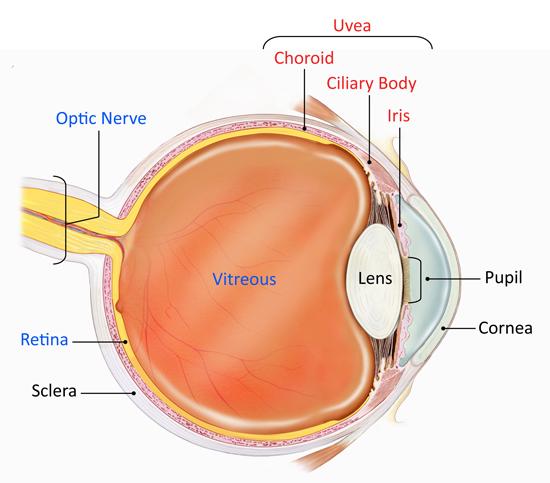Uveïtis
- Article
- 2021-01-31
Uveitis is a general term that describes a group of inflammatory diseases that cause swelling and destroy eye tissue. These diseases can slightly impair vision or lead to severe vision loss. The term "uveitis" is used because the diseases often affect a part of the eye called uvea. Nevertheless, uveitis is not limited to the uvea. These diseases also affect the lens, retina, optic nerve and vitreous humor and cause impaired vision or blindness. Uveitis can be caused by problems or diseases in the eye, or it can be part of an inflammatory disease that affects other parts of the body. It can happen at any age and mainly affects people between the ages of 20 and 60. Uveitis can last for a short (acute) or long (chronic) time. The most severe forms of uveitis often recur. Eye care professionals can more specifically describe the disease as: Eye care professionals may also describe the disease as infectious or non-infectious uveitis. The uvea is the middle layer of the eye that contains many of the eye's blood vessels (see diagram). This is one way for inflammatory cells to enter the eye. Located between the sclera, the white outer layer of the eye and the inner layer of the eye called the retina, the uvea consists of the iris, the ciliary body and the choroid: Iris: the colored circle at the front of the eye. It determines the color of the eyes, secretes nutrients to keep the lens healthy, and controls the amount of light entering the eye by adjusting the size of the pupil. Ciliary body: It is located between the iris and the choroid. It helps the eye focus by regulating the shape of the lens and it provides nutrients to keep the lens healthy. Choroid: A thin, spongy network of blood vessels, which mainly supplies nutrients to the retina. Uveitis disrupts vision mainly causing problems with the lens, retina, optic nerve and vitreous humor (see diagram): Lens: transparent fabric that lets light into the eye. Retina: The layer of cells on the back, in a part of the eye that converts light into electrical signals that are sent to the brain. Optic nerve: A bundle of nerve fibers that carries electrical signals from the retina to the brain. Vitreous: The fluid-filled space in the eye. Uveitis is caused by inflammatory reactions in the eye. Inflammation is the body's natural response to tissue damage, germs, or toxins. It causes swelling, redness, heat and destroys tissues as certain white blood cells rush to the affected part of the body to control or eliminate the insult. Uveitis can be caused by: The disease causes symptoms, such as decreased vision, pain, sensitivity to light and increased floaters. In many cases, the cause is unknown. Uveitis can be associated with many diseases, including: Uveitis is usually classified based on where it occurs in the eye. Anterior uveitis occurs on the front of the eye. It is the most common form of uveitis, mainly affecting young and middle-aged people. Many cases occur in healthy people and can affect only one eye, but some have been associated with rheumatological, skin, gastrointestinal, lung and infectious diseases. Intermediate uveitis is often seen in young adults. The center of the inflammation often appears in the vitreous (see diagram). It has been linked to a variety of conditions, including sarcoidosis and multiple sclerosis. Posterior uveitis is the least common form of uveitis. It mainly occurs in the back of the eye, often with both the retina and choroid. It is often referred to as choroditis or chorioretinitis. There are many infectious and non-infectious causes of posterior uveitis. Panuveitis is a term used when all three major parts of the eye are affected by inflammation. Behcet's disease is one of the best known forms of pan-uveitis and it damages the retina enormously. Intermediate, posterior, and panuveitis are the most severe and highly recurring forms of uveitis. They often cause blindness if left untreated. Uveitis can affect one or both eyes. Symptoms can develop quickly and can include: Anyone who experiences eye pain, severe photosensitivity, and any change in vision should be immediately examined by an ophthalmologist. The signs and symptoms of uveitis depend on the type of inflammation. Acute anterior uveitis can occur in one or both eyes and is characterized in adults by eye pain, blurred vision, Did you not find what you were looking for? Search further in the What is the uvea and which parts of the eye are most affected by uveitis?

What Causes Uveitis?
What diseases are associated with uveitis?
What are the types of uveitis?
What is anterior uveitis?
What is Intermediate Uveitis?
What is Posterior Uveitis?
What Is Panuveitis?
What Are the Symptoms of Uveitis?

